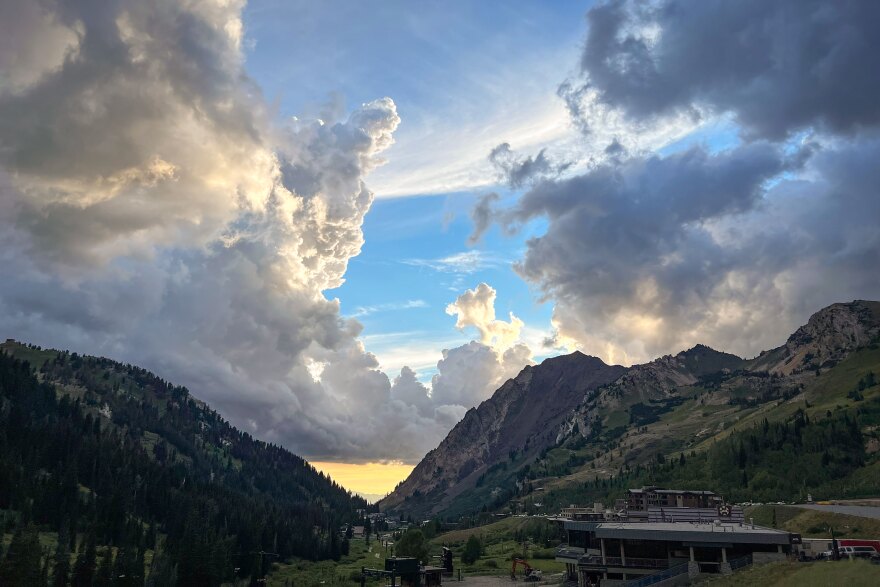The Utah Department of Transportation identified the gondola as its preferred alternative to address traffic issues in Little Cottonwood Canyon — but the agency doesn’t currently have enough money for it and for now, plans to enhance bus service.
This announcement follows more than 14,000 comments that were submitted in relation to the project’s environmental review. There were two alternatives on the table: more buses with a widened road or a gondola from the La Caille restaurant at the base to Alta and Snowbird ski resorts.
“I understand this is a project that will potentially change the canyon for current users and the next generation of users — the number of comments we've gotten clearly indicate that passion,” said UDOT Project Manager Josh Van Jura. “There are people that are supporters for all of the alternatives. I think the important point is we've reached a milestone that begins the next phase of the project.”
The price tag for the gondola proposal is $550 million, which includes a base station with 2,500 parking spots, tolling infrastructure and the widening of Wasatch Boulevard. It’ll cost $4 million a year to operate the gondola in the winter, and if service is expanded to the summer, it’ll cost an additional $3 million, according to UDOT.
Van Jura acknowledged the project isn’t funded, which is why the agency proposes a phased implementation of the gondola plan. That way UDOT can “alleviate mobility, reliability and safety concerns that exist today while addressing the long-term transportation need in the canyon.”
The short-term plan is to increase and improve bus service, toll or restrict single occupancy vehicles and build mobility hubs. It may take years to secure federal, state and potential private funding for the gondola, according to Van Jura.
Some gondola opponents see the phased approach as a silver lining. Carl Fisher, the executive director of Save Our Canyons, said people will have the chance to test out a better bus system in the meantime.
“If people rise to the occasion, if they take transit, if they start carpooling and stop driving themselves up solo in these canyons, we may well have an opportunity to stave off [UDOT’s] ultimate decision, which is a gondola,” he said.
Fisher is disappointed by the move to build a gondola, increase parking and widen roads because it shows that UDOT is prioritizing and investing in cars, rather than other modes of transportation.
Brad Rutledge, a co-founder and board member with Wasatch Backcountry Alliance, agrees it’s up to people to show what kind of service they want. His group already runs a free shuttle for backcountry users and encourages people to use other ways to get up the canyon.
“We access trails to hike, bike and snowshoe, and the gondola does not service that community of users,” he said. “Let's not wait for the government to do something that we don't want. Users of Little Cottonwood Canyon have universally said, we don't want a gondola. So now it's in our hands to change our behavior.”
Salt Lake County Mayor Jenny Wilson and other local leaders have been vocal in their opposition to the gondola. During a Wednesday news conference, Wilson said the gondola’s price tag is concerning and she encouraged people to voice their concerns to UDOT.
“I'm a taxpayer. I'm a resident. The idea of writing a check of public dollars for a half a billion dollar investment, that is concerning to me,” she said. “[It’s] even more concerning as a mayor when we look at all of the needs in our community, deep transportation needs elsewhere, but also human services needs and the list goes on.”
While the gondola would run throughout the winter, Wilson said it would only serve Alta and Snowbird, the two resorts up Little Cottonwood Canyon, and that it would only be helpful on very busy days. She estimates there are only 15 to 20 of those days a year.
Alta Ski Area President and General Manager Mike Maughan said when it comes to helping fund the gondola, the resort is investing in “some services” at the landing sites, including the infrastructure, restrooms and food options. He didn’t say whether they would help fund the needed $550 million.
To him, the gondola benefits the public and not just the resorts.
“We don't gain any revenue specifically from the gondola other than it may help people to get here in that process,” Maughan said. “It's really a service for the general public because it's enhancing their ability to go to a destination that they choose to recreate at. It's no different than someone saying, ‘I want to use Trax to go to the Jazz game.’”
Maughan said the short-term plans for the canyon could help but he likes the gondola best because it “takes the road out of the equation.”
Snowbird President and General Manager Dave Fields said his resort applauds UDOT for selecting a gondola. His statement called it “the safest, most reliable and least polluting” way of transporting people up the canyon. The Salt Lake Tribune reported in July that Snowbird bought land at the mouth of the canyon where the base station would go.
The final environmental impact statement for the gondola project is open for public comment until Oct. 17 and a final decision from UDOT is expected this winter.




